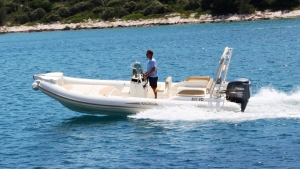
Motorboating is an extremely popular activity through out Europe, where over 3.6 million motor boats are registered. However, recreational boating is risky, especially when mixed with tourists, alcohol and inexperience. Most fatal boating accidents take place on smaller motorboats (less than 16 feet in length). Alcohol is estimated to be involved in one third of all boating fatalities. In Finland, a study showed that alcohol was involved in more than 63% of boating deaths.
Why motorboats can be risky for children and youth?
While most young children wear PFDs on motorboats, very few older children are willing to, which is especially alarming because they represent a high risk group for drowning. Additionally, teenagers may be inclined to drink alcohol while boating, which will greatly increase the chance of an accident. Studies show that intoxicated passengers carry nearly as high a risk of injury as intoxicated boat operators, whether the boat is moving or not!
One of the greatest risks to children on motorboats is the propeller. Statistics show that nearly half of propeller injury victims are children. Children are likely to want to swim near the boat, or may be hurt while water-tubing behind the boat, or perhaps are more likely to fall overboard and be struck. Boats can be fitted with a pop-guard which will help protect against propeller strikes.
Most motorboat accidents are not caused by faulty equipment, but rather by careless behavior, alcohol, poor supervision, or lack of preparation for handling a small emergency such as a storm or a fall overboard.
Recommendations for boating with children
● Only people with previous boating education should be permitted to rent a boat.
● Nobody who has been drinking should be allowed to operate or ride in the motorboat.
● All passengers must wear a personal flotation device.
● Show all passengers the location of the propeller.
● Always stop the engine and put the boat in gear before any passenger swims.
● Keep a wide berth from swimmers and be alert for diver flags and zoning buoys.
● Small children may be most safely seated on the floor of the boat.
● Child passengers should be told beforehand how to safely enter and exit the boat, about the rules for swimming, where to sit safely, and the location of the propeller.
● Instruct parents to never fasten a child to a motorboat, this could prove fatal in a capsise.
● Have renters leave a plan on where they will be boating, and when they expect to return. This will aid in a search should they not return. Approximately 70% of all fatal accidents occur on motorboats where the operator has not received boating safety instruction.
● In case of a fall overboard, boat operators should be instructed to turn the bow of the boat toward the swimmer and immediately cut the engine to avoid propeller strikes.
● If the boaters will be engaging in tow sports such as water-skiing, be sure that there will be at least 2 adults onboard, one to drive the boat with the neccessary license (certified ski instructor), the other to monitor the tow line and the skier.
What safety factors to look for in choosing equipment for your operation?
Most significant is to consider what your client base really needs. Most renters of motorboats simply want to boat freely about in the water, and will not be seeking the strongest engine or the fastest racing boat. In fact, it may be a siginificant safety advantage to not provide such boats! When renting to groups and families, be sure the boat is not especially prone to capsise, that the boat design allows for easy entry and exit from the water should renters wish to swim while boating, that the entry and exit points will not bring people too close in contact to the propeller, and that there are secure areas for children to be seated.
Staff Preparedness
● All staff should be trained in CPR and first aid.
● Always have at least 2 staff members present – one to speak with customers and handle training, another to monitor the water.
● A life saving vehicle should be at hand.
● Motorboats should be equipped with a quick stop (a cord which attaches to the steering wheel and the driver’s wrist, and which will stop the engine should the driver go overboard).
● All motorboats should be supplied with the following: an oar, a fire extinguisher, and a first aid kit, and if space allows, an anchor.
● All staff members should be able to clearly communicate the risks and safety rules to clients. A language barrier could pose a problem should an accident occur, both in terms of immediate medical care and liability for having failed to properly communicate the rules.
*Source : European Child Safety Alliance, Eurosafe; 2008.- With the support of the European Commission













